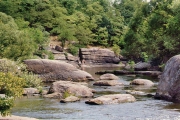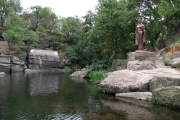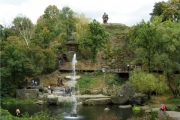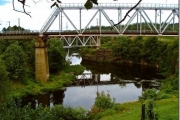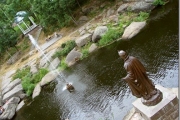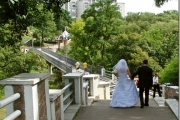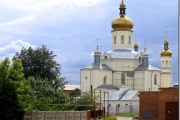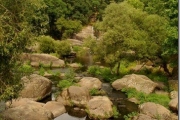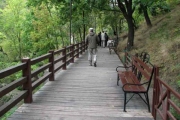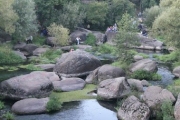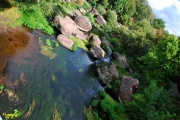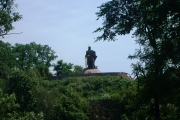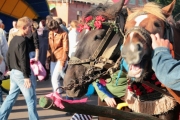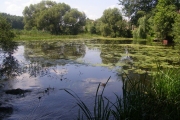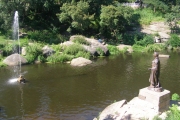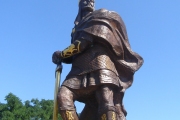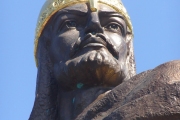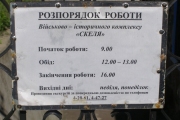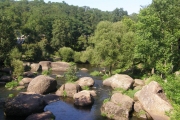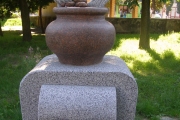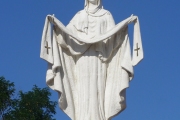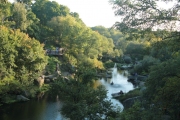|
Viewings: 14251
Many people know Korosten, Zhytomyr regional center, as a large railway junction, but not all guess that this town is one of the oldest in Ukraine.History. Already in excess of the Millennium looks with steep rocky coast city in its reflection in the river Uzh. Archeologists have proved that in the end of VII century here at the crossroads of trade routes, there was hail Iskorosten, the capital of the tribe of Drevlyans. Surrounded by thick forests, he was all out of wood, with oak paling around the city walls (IP-Coro-the darkness"), did not want to obey the princes of Kiev: in 914 the city for the first time, remember the Chronicles in connection with the suppression by Prince Igor of an uprising of the drevlyani. When in 945 Igor again visited in the city, demanding tribute, Prince of drevlyan Small raised his army, defeated Kyiv squad. The neighboring village of Poliske many centuries was called Grave: according to legend, this is where they buried Drevlyane killed Prince Igor poured on his grave mound. In the XIV century the city is part of the Great Lithuanian Principality, with 1385 goes to the Polish Kingdom. In 1589, the owner of Iskorosten Prokop Krieviski seeking to settle the Magdeburg rights. Iskorostenskaya fortress in 1649 was captured and destroyed by a group of Cossacks under the leadership of Geroski. Since 1795 the town became part of the Empire of the Romanovs. Old princely glory dissipated on the wind, Iskorosten at the beginning of the XIX century was turned into a quiet provincial town, inhabited mainly by Jews and Ukrainian peasants. Only when by Iskorosten railway ran Kyiv-Kovel (1902), the situation has changed. And the name of the city too: Korosten ' has entered the twentieth century significant railway junction. During the First world war some of the Russian officers were excavated burial mound of Prince Igor find there Varangian the sword of the X century and a human skeleton. Modern city. The city, which was completely destroyed during the Second world war, cannot boast of ancient architectural sights. The settlement of Prince Mal will not find in its place granite quarry. The tragic adjacent to the Chernobyl NPP (only 80 km) long, too pushed potential tourists: Korosten ' has got in "the zone of guaranteed voluntary resettlement". Although travellers should visit: Korosten famous not only for its porcelain and valuable kinds of granite, but also the burial-mounds VIII-X century, which are situated at the building of the city Council. And in the city Park are situated the so-called Olgina baths (huge granite boulders on the grass-Snake), the name of which is connected with Princess Olga. In September 2005, the city celebrated its 1300-Yu Gotovina. 12 places to visit in Korosten. All outstanding location Korosten are at a distance of 1-2 km from each other, because they are, without haste, walking, it is possible to see during the day. For those who don't like a lot of walking, taxi, which in Korosten very cheap and in a great number. 1. The city Park. Located on both banks of a picturesque canyon, in the depths of which flows the river Uzh. In the Park you can sunbathe on the large flat granite rocks, swim in the warm water on the rocks, swim in the rapids in cold water, under the supervision of experts to jump in the water five-meter cliff, rafting, imagine yourself a mountain to climb to the very high slope, just walk picturesque shady avenues. The Park is suitable and pensioners, and extreme youth. Both parts of the Park are connected by a beautiful pedestrian bridge. For the beauty of the Korosten city Park can compete even with the famous " Sofiyivka " in Uman, but if last - man-made landscape, Korosten Park-natural. 2. Defence underground place. Defence underground village is located in the city Park. He built his famous General Karbyshev in 1937. Here a small garrison almost a month kept the defense against the Germans during the Second world war. The old-timers say that to enter the dungeon fascists were able only after he had used some gas. This was a violation of applicable at the time of the rules of war, because then between Moscow and Berlin acted achieved through the mediation of the Swiss red cross gentleman's agreement that the Nazis never used gases, and Soviet troops do not use flammable substances like Napalm in reactive mines Katyusha. When the Germans finally captured underground Bastion, the only survivor three of his defenders. Among them was a woman and seriously injured the officer. The Germans were so impressed by the heroism of those people that all three were left alive. Until 2005, the facility was classified. Currently opened for tourists only one floor underground. In fact, these underground floors explored seven rumored to them anymore. Bastion even currently has military significance, because there still remained Autonomous water and air supply of different points of the city. 3. Monument to Prince Mal. Installed at the cliff above the river Uzh, on the occasion of the 1300-year anniversary of the city. The author of a 10-meter figure of the Prince Mal, made of copper, is a sculptor Igor Zarechny. Mal is depicted as a warrior in ancient armor which relies on a heavy sword. A picturesque place for the monument was chosen not by accident. Here the troops of Prince Mal, rebelled against the intolerable exactions of the Kiev Prince Igor, got the victory over the Prince's retinue in 945, and Igor was executed after the trial. Small - second of known Korosten princes. The first was his father Niskinya. The grandson of Niskinya was famous epic hero of us all, one of the three heroes Dobrynya Niskinich, which over time turned into Dobrynya Nikitich. Interestingly, in Korosten currently home to dozens of families with surnames Nikitich, which are the direct descendants of the Prince of Niskinya. 4. Red hill. The hill where it was found one of the four iskorostenskaya ancient settlements. Here is the Castle, where, according to archaeologists, was the residence Drevlyansky Prince Small. This place was also found traces of the fire and the big battle, which, according to the scientists, most likely occurred during the storming of the rebellious Iskorosten combatants of Princess Olga. The location of the skeletons, weapons suggests that people fought bravely at the time when the town was burning. Archaeologists have dug up not only housing, but also the jewelry workshop of the XII century. Here were found such jewelry, which have no analogues in Europe. The most interesting of them are the Museum of local lore. In General, archeological excavations, which 2003-2004 was held under the leadership of candidate of historical Sciences Twittascope, proved: Korosten already in the beginning of VIII century there lived people, whose life was quite economically developed and organized on the principles of a walled and fortified settlements. 5. The suspension bridge connects the right and left banks of the river Uzh. This is one of the largest pedestrian suspension bridges on one leg in Europe. It offers scenic views of the river. 6. The Monument Covers The Mother Of God. Installed at the entrance to the Central Park. This is almost the only Orthodox religious monument in Ukraine. Korosteny chose the mother of God the Protectress of the city. On the Cover of city residents celebrate their dedication day. 7. St. Olga Church is also located next to the Central Park. The name of the Church shows that korosteny forgave Princess Olga, who burned their city. The citizens believe in the legend that Olga felt guilty for the burnt city and for the sake of repentance on the steeper about Snake Princess built the temple, which came to atone for their sins. In addition, the Holy Olga korosteny respect as the foremother of Christianity in Russia. Because Olga, the fact that baptism which in the year 946, during her voyage to Constantinople, no doubt among historians, brought Christianity princely dynasty. 8. Museum of local lore. Recently restored. Operates since 1924. It was the first Museum in the city, where he worked enthusiasts Museum, famous Ukrainian scientists - archeologists, ethnographers, historians: Fedor Kozubovsky (first Director of the Museum), Konstantin Worm, Nicephorus Dmitruk. Then in the 30's, they were all arrested. In the years of the great Patriotic war Museum was destroyed. A new exhibit opened only in 1987. Artifacts that tell about the nature and history of Korosten of the region from ancient times to our days, currently has 20 thousand units. After the excavations of Krasnaya Gorka in 2001-2004 was added to the Museum collection of unique finds large collection of ceramics VI-X centuries ad and unique jewelry worn by Drevlyanka. 9. Interesting is and Amateur ethnographic Museum, housed in the 5th school for two kilometers from Museum of local lore. Here presents Polesskiye rural starozitnosti and assembled ancient woodland house of the XVIII century with all home utensils, characteristic of that era. This exhibit is of great admiration modern city dwellers, because it gives the opportunity to travel back in time in two centuries ago, to feel the atmosphere that prevailed in their rural housing ancestors, to touch such forgotten now things as kadub, Skalka, the reel. 10. Technical Museum operates in the Locomotive depot. Causes admiration of fans of history of technics, who come here from all over Europe. Connoisseurs technical antiquities from Germany, great Britain visits Korosten to rent here is the locomotive of the early twentieth century and ride in the train triangle Korosten-Zhytomyr-Kyiv-Korosten. 11. The monument to the Trident is set in the Park of about Korosten train station. It has chosen not casually: the Trident as the national emblem of Ukraine was first used in 1918 in Korosten on this place, when, after the Bolshevik seizure of Kyiv Central Council moved to Zhytomyr, and then in Korosten. In the HQ car and decided to elect Trident coat of arms of the UPR. 12. Potato pancakes monument. 8 September in Kerosene will be the fifth anniversary international festival derungs cooks from different countries will demonstrate their art of cooking deruny or near-potato dishes, and tasters and visitors of the festival will determine the best dishes and reward their authors. Each of the guests of the festival will be able to buy a patent for the right tasting, giving the right to try all types of potato products and set personal evaluation. The festival will be held different contests, quizzes, exhibitions, to guarantee guests a good mood and many pleasant impressions. In 2008, korosteny made the biggest Deron in Ukraine weight 118 kg, which was entered into the Book of records of Ukraine. At the Second International festival of potato pancakes in 2009 in Korosten was inaugurated potato pancakes monument.  Com-Eva: 0 Com-Eva: 0
You are reading news Коростень – столица древлян, подземный городок и купальня княгини Ольги
if You liked the article Коростень – столица древлян, подземный городок и купальня княгини Ольги,
prokomentiruet her.
|
The world of the unknown - Onua.org
Onua.org - this site created to familiarize the user with the world of the unknown, news of technology, space discoveries and mysteries of the Earth UFO, Video , Photo, the Witnesses, the mysteries of history and ancient civilizations.
Menu
- Anomalies
- Hypothesis
- The Mysteries Of History
- Unknown
- News
- Opening
- Top secret
- Prophets
- Ancient civilizations
- Egypt
- Rome
- Greece
- Anunaki
- Nazca
- Maya
- Cosmos
- Technology
- Flora and Fauna
- Atlantis
- Bermuda triangle
- Aliens and UFOs
- Cloning
- Loch Ness
- Mysticism and Magic
- Time machine
- Parallel world
- The Tunguska meteorite
- Third Reich
- Teleportation
- Snow man
- 2012
- Nibiru
- Solar system
- The sun
- Earth
- Mars
- The rest of the planet
- Photo
- Video
- A little about everything
- Украинские аномалии
- 2013-2014 YEAR
- Questions and answers
- 100 great
Interesting
Recent VIDEOS
News calendar
Join
Popular Onua.org
Photo

The biggest fish in the world - not blue whale as one might think, because the whale belongs to a ma

Before it was invented fridge, its functions were performed in the ice, which was considered a preci
Предлагаем восстановить, заказать, купить диплом Вуза в любом городе России. Только настоящий бланк ГОЗНАК с гарантией.













